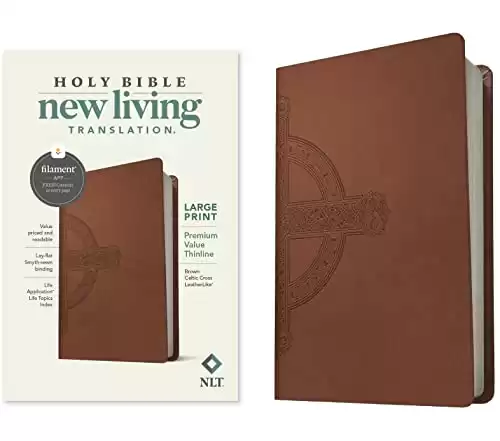When it comes to the Bible, there are two main translation choices for English readers; ESV and NLT are some of the versions that stand out.
Both are easy to read, have clear pronunciation guides and make it easy to find specific verses.
However, some subtle differences between these translations will help you decide which one might be right.
Let’s examine their similarities and differences to determine what version is best!
Origin of ESV and NLT Bible
The ESV Bible is based on the original Hebrew and Greek texts, while the NLT Bible was translated from those same texts.
Now that we’ve established some background info, let’s get into how these two versions came to be.
The ESV Bible was translated by a team of 100 scholars over 15 years, making it one of the most trusted modern translations available today.
It is not only an accurate translation but also emphasizes readability and contemporary language so that it can be easily understood by those who are new to Scripture or have English as their second language.
The NLT Bible was translated by experts who worked for four years to ensure accuracy, fidelity to God’s Word, and clarity for today’s reader.
Translation
The ESV is more literal than the New Living Translation (NLT), which means that it is more inclined to the original languages of the Bible.
The ESV Bible uses older forms of English, and it’s less likely to include contemporary slang words or phrases.
The NLT has been called “dynamic equivalent,” meaning that it uses modern language for difficult words in Scripture without sacrificing precision.
The ESV Bible can be understood by someone who knows little about theology, but not everyone will appreciate its use of formal language.
This isn’t a problem with the NLT, which has a more conversational tone and includes popular culture references where appropriate.
However, some people may find this approach misleading because it can make them think they’re reading something new when nothing has changed!
Style
The ESV is more formal, with a stronger emphasis on accuracy and precision. The NLT is more conversational, with a greater emphasis on clarity.
The ESV is more accurate than the NLT because it closely follows Greek texts in its wording, but this also means it’s not as easy to read.
On the other hand, although less literal than other translations such as NASB or KJV (King James Version), the NLT reads smoother than most Bibles due to its modern language style and vocabulary choices.
Reading and Comprehension Level
ESV is written at a higher reading level than NLT. This means that it’s more challenging to read and comprehend than NLT, but you will also have a stronger foundation of knowledge in your understanding of the Bible.
Purpose of Each Bible Version
The ESV Bible is a translation of the Bible from its original languages, while the NLT Bible is a paraphrase of the Bible.
A literal translation ensures that words are translated word-for-word, while a more dynamic equivalence translation tries to capture more of the meaning behind the words.
The ESV Bible has a formal equivalence approach to translating its text, making it as literal as possible while communicating clearly in English.
Pronunciation Guide
The ESV has a pronunciation guide at the beginning of each book. The NLT does not have a pronunciation guide.
The ESV pronunciation guide is more accurate than the NLT’s since it follows standard American English pronunciation rules, while the NLT uses British English pronunciations in most cases.
If you’re learning English, using the ESV may be better than using the NLT because all words will sound more familiar and natural to your ear.
Footnotes and Cross-References
The ESV Bible has footnotes that help clarify difficult passages.
It also offers one of the most extensive cross-referencing systems among modern translations and helpful concordance.
The footnotes in the NLT are very similar to those used in the NIV.
The references at the bottom of each page include cross-references, notes on translation issues, and other information that may be helpful to readers.
Cross-references are listed at the end of a verse or passage and indicate where a related passage can be found in the Scripture.
Bible verse Comparison
James 4:11
NLT: “Don’t speak evil against each other, dear brothers and sisters. If you criticize and judge each other, then you are criticizing and judging God’s law. But your job is to obey the law, not to judge whether it applies to you.”
ESV: “Do not speak evil against one another, brothers. The one who speaks against a brother or judges his brother, speaks evil against the law and judges the law. But if you judge the law, you are not a doer of the law but a judge.”
Genesis 7:23
NLT: “God wiped out every living thing on the earth, people, livestock, small animals that scurry along the ground, and the birds of the sky. All were destroyed. The only people who survived were Noah and those with him in the boat.”
ESV: “He blotted out every living thing that was on the face of the ground, man and animals and creeping things and birds of the heavens. They were blotted out from the earth. Only Noah was left, and those who were with him in the ark.”
Best For Bible Studies
The ESV is probably better if you’re more serious about your Bible study. It has a reputation for being more literal than the NLT and less prone to paraphrase.
If reading scripture is essential to you but reading it publicly isn’t something that makes you nervous, then the NLT might be your best bet.
The language of this translation will help make scripture accessible to everyone around you while preserving its integrity as an accurate translation.
Pros and Cons of the ESV Bible
The ESV Bible is a good choice for those who want a Bible version close to the original text.
The ESV Bible uses gender-inclusive language and can help people understand the Bible more modernly.
However, there are some cons to this Bible. It may be difficult to understand if you’re not used to reading old English because things like “thee” and “thou” are not commonly used anymore.
Also, some readers might find that the ESV changes some words from other versions of the Bible without explaining why these particular changes were made, making it hard for them to understand what’s going on in certain parts of scripture.*
New Living Translation Bible Pros and Cons
NLT Pros and Cons
Pros
Its readable format makes reading the entire Bible easy and even easier when studying Scripture.
NLT sets itself apart by translating the Bible so that its message is immediately apparent, “How does this apply to my life?” Having a Bible allows it to transform one’s life, and NLT achieves that goal well.
Con
The New Living Translation borrowed many verses from the Living Bible.
In its effort to provide translations that are true to the original meaning of a passage, NLT often sacrifices accuracy for clarity.
Some Christians feel that the gender-inclusive language of the NLT adds to Scripture.
ESV Pros and Cons
Pro
ESV is a literal translation, hence it is highly accurate.
It has footnotes in places that can be hard to understand
The ESV has an excellent set of cross-references and a helpful concordance.
Cons
The ESV translation uses some of the same languages as the RSV.
It has awkward language, obscure idioms, and irregular word order, making it difficult to read.
Does The Esv Bible Have Missing Verses? And What Are Some Of Them?
The ESV Bible is missing some verses of the Bible. The translators intentionally left out verses they could not find in the oldest manuscript.
Therefore those verses are not included in their translation (there is a list of them below).
Some examples of missing verses include Matthew 18:11; Mark 16:9-20; Luke 22:43-44; and others listed at
Does The Esv Bible Have Missing Verses? And What Are Some Of Them?
Yes, some verses are missing in the NLT. Here are some examples:
- Mark 7:16 – entire verse omitted
- Matthew 17:21 – whole verse omitted
- Luke 17:36 – whole verse omitted
- John 5:4 – whole verse omitted
Which Version is Best?
In the end, you’ll likely need to try out both versions to see which works best.
Both the ESV and NIV have their strengths and weaknesses; they both have large audiences that love them.
Both the ESV and NLT are excellent translations. They are each based on the original languages and represent the Word of God accurately and faithfully.
Both translations are easy to read, understand, and apply to daily life.
The ESV is a literal translation of the original language.
It uses archaic words and phrases that may not be familiar to modern readers, but it is very accurate in conveying what the Hebrew and Greek texts say.
Conclusion
With multiple resources available, choosing the right Bible translation can seem daunting. It’s essential to consider your intended purpose for reading the Bible.
The ESV and NLT are both outstanding translations with unique features that may be better suited for your needs.
Hopefully, this comparison will make it easier for you to choose which Bible translation best fits your preferences.


